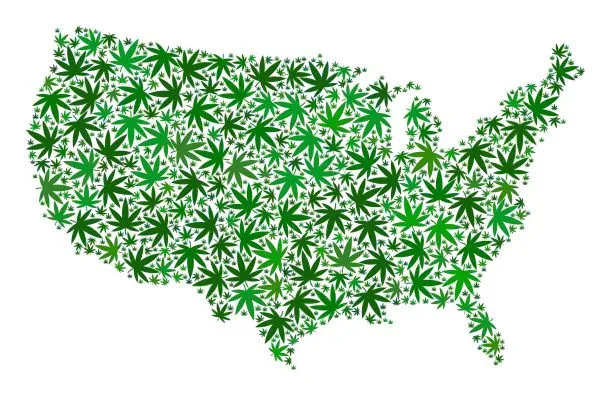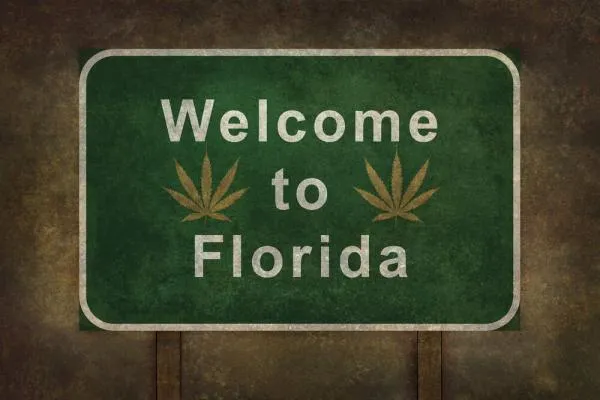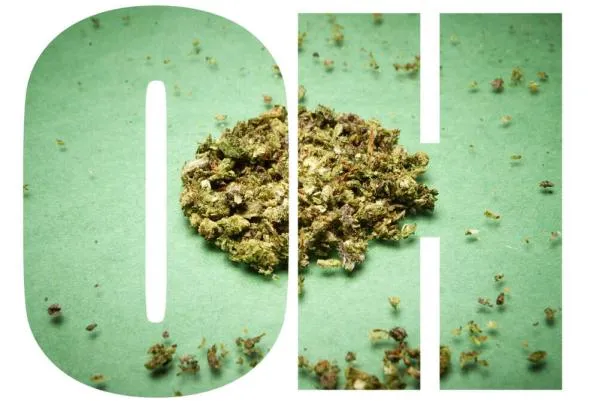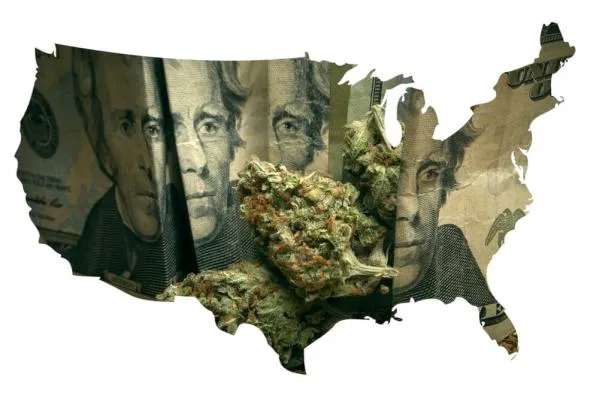Ever wondered where you can legally cultivate your own cannabis garden? Find out which states let you roll up your sleeves and plant those seeds. We'll guide you through the rules, top strains, and expert tips!
Green = Fully Legal
Orange = Medical only
Blue = Illegal
States where growing weed is legal
The cannabis industry in the US is expanding year on year and now it is legal to grow marijuana in 25 states providing they stick to regulations concerning age, the number of plants, and the maturity of those plants. Here are the rules by state:
Alaska
In Alaska, adults 21 and over can cultivate up to six marijuana plants, with no more than three mature plants growing at any one time and no more than 12 plants per household. This allowance is for both medical and recreational use.
Arizona
Residents of Arizona, who are over 21 years old, can grow up to six cannabis plants at home. If you have a medical marijuana card you can grow up to 12 plants.
California
California allows individuals 21 or older to grow up to six cannabis plants at home. However, all plants must be kept in a locked space and not be visible from public places.
Colorado
Adults in Colorado can cultivate up to six marijuana plants per person, with no more than three being mature at a time. The maximum per house is 12 plants.
Connecticut
In Connecticut you can grow up to six plants for medical and recreational use providing only 3 are mature at any one time.
Hawaii
Providing you are a medical patient and over the age of 21, you can grow up to 7 cannabis plants per person. If you have a medical marijuana card you can grow up to 10 plants.
Illinois
In Illinois providing you have a medical marijuana card you can grow up to 5 cannabis plants.
Maine
If you live in Maine, you must be at least 21 years old and can grow up to three mature plants, six immature plants, and an unlimited number of seedlings.
Maryland
Recreational users can grow up to 2 plants per household and if you successfully apply for a medical card this will increase to 4 plants per household.
Massachusetts
In Massachusetts, adults over 21 can grow up to six cannabis plants per person, with a maximum of 6 plants per person or if you are living in a shared house, up to 12 plants per household.
Michigan
In Michigan, providing you are over the age of 21, you can grow up to 12 marijuana plants at home for recreational use.
Minnesota
In Minnesota recreational growers can cultivate up to 8 plants providing no more than 4 of them are mature at any one time. If you get yourself a medical card you can grow up to 16 plants.
Missouri
In Missouri medical and recreational users can grow up to 6 plants per person or if you are in a shared house with more than one adult up to 12 plants per household with a medical marijuana card.
Montana
Adults in Montana can grow up to 8 cannabis plants per person providing no more than 4 of them are mature at any one time.
Nevada
In Nevada if you live more than 40 kilometers from your nearest dispensary and are over 21 years old, you can grow up to 6 plants for recreational or 12 plants for medical use.
New Mexico
If you live in New Mexico recreational growers can cultivate up to 16 cannabis plants providing no more then 4 are mature at any one time.
New York
In New York medical or recreational growers can cultivate up to 6 plants per person with 3 being mature or in shared households up to 12 plants with 6 being mature.
Ohio
If you live in Ohio, it is legal to grow up to 6 plants per person or 12 plants per residence if you live in a shared household.
Oklahoma
In Oklahoma medical cannabis patients are allowed to grow up to 6 plants and 6 seedlings at any one time.
Oregon
In Oregon, the law permits medical patients to grow of to 18 seedlings and 6 mature plants or 4 plants per household if you are growing recreationally.
Rhode Island
It is legal to grow up to 12 plants with 12 seedlings for both for registered medical users and 6 plants with 3 of them mature for recreational growers.
South Dakota
In South Dakota medical cannabis patients can grow up to 4 plants providing that only 2 of them are mature at any one time.
Vermont
Residents of Vermont, 21 years of age or older, can grow up to 9 cannabis plants, with no more than two being mature at any given time.
Virginia
In Virgina, recreational and medical users are allowed to grow up to a maximum of 4 cannabis plants per household.
Washington
Washington State allows the cultivation of marijuana for medicinal purposes only. Qualifying patients can grow up to six plants, or fifteen with a doctor's authorization.
States where growing is illegal but medical marijuana is legal
In several U.S. states, while you cannot grow marijuana for any purpose, you can legally purchase and possess medical cannabis under certain conditions. Here's a look at some of these states:
Alabama
In Alabama patients with a valid prescription can possess up to 70 daily doses at any one time.
Arkansas
Arkansas legalized medical marijuana in 2016. If you have a medical card you can purchase up to 2.5 ounces of marijuana every 14 days from licensed dispensaries.
Delaware
In Delaware medical patients can possess up to 6 ounces of cannabis at any one time.
Florida
In Florida medical patients can have either a 3 x 70-day supplies or 6 x 35-day supplies. To simplify this a little, a 35-day supply is classified as 2.5 ounces.
Georgia
Georgia permits the use of cannabis extracts high in CBD, with less than 5% THC, for treating specific medical conditions since 2015.
Kentucky
Medical users can legally possess a 30-day supply of cannabis.
Louisiana
Since 2016, residents of Louisiana with qualifying medical conditions can obtain a 30-day supply of medical marijuana.
Mississippi
Medical patients can possess up to 3 ounces of cannabis per month.
New Hampshire
Since 2013 medical marijuana patients are allowed to possess up to two ounces of usable cannabis.
New Jersey
Providing you have a medical marijuana card in New Jersey, you can possess up to a 90-day supply of 8 ounces of cannabis.
North Dakota
North Dakota offers medical marijuana for residents with certain conditions since 2016. Patients may possess up to three ounces of marijuana but must purchase it through state-approved facilities as cultivation is banned.
Pennsylvania
Pennsylvania has permitted medical marijuana since 2016. Qualifying patients can obtain a 90-day supply.
Utah
Medical users are allowed to possess a 30-day supply or up to 4 ounces.
Which U.S territories have legalized marijuana?
Marijuana legalization varies across U.S. territories, with different rules regarding medical and recreational use:
Guam
Guam has legalized both medical and recreational marijuana, allowing residents and visitors to legally access cannabis under specific regulations.
Puerto Rico
In Puerto Rico, marijuana is legal for medical use. Patients with qualifying conditions can access cannabis through regulated dispensaries.
Northern Mariana Islands
The Northern Mariana Islands have approved the use of marijuana for both medical and recreational purposes, providing comprehensive access to cannabis.
U.S. Virgin Islands
Similar to Guam and the Northern Mariana Islands, the U.S. Virgin Islands have legalized marijuana for both medical and recreational use.
American Samoa
In contrast, American Samoa has not legalized marijuana for either medical or recreational purposes, maintaining a prohibition on the substance.
What are the best strains to grow at home?
When deciding on the best cannabis strains to grow at home, understanding the differences between autoflowering and feminized seeds is key. Autos offer fast turnarounds and convenience whereas feminized (photoperiods) offer much larger yields but can become too unwieldly for smaller indoor grow spaces.
Autoflowering seeds are ideal for beginners who want to grow weed indoors with limited space, such as balconies or closets. All autoflowers originate from a cross of Ruderalis genetics, which naturally flower based on age rather than light cycle changes. They are much more forgiving of grower errors and less sensitive to cold weather, making them easier to manage. Autoflowers typically grow faster and are ready for harvest in as little 8 weeks. They tend to be smaller and bushier, with smaller but more manageable yields than feminized plants but are a smart choice if you are looking for a quick turnaround with minimal maintenance.
On the other hand, allow you If your goal is to maximize yield and potency, feminized photoperiods might be the better choice. Their photoperiodic nature means that they will only flower once you change the light cycle from 18/6 to 12/12. This gives you have full control over the vegetative and flowering stages allowing you to veg for longer and produce much bigger yields. Growing feminized seeds requires a bit more skill however as you will need to manage the light cycles and size of the plant which can be tricky in smaller spaces. Indica strains are sometimes preferred for indoor grows because they are shorter and therefore much easier to maintain whereas sativa strains can grow well over 6 foot if not properly controlled with plant training techniques.
Comparison and Suitability:
Autoflowering Seeds: Best for novice growers, those with limited space, or growers looking for a quick grow cycle. They are low maintenance, fast but lower yielding.
Feminized Seeds: Ideal for experienced growers aiming for maximum yield and potency, who have more space available and can manage the more complex light requirements and plant care.








However, it really depends if you are growing indoors or outdoors and what light cycle you use. On average the veg stage takes 4-8 weeks, but if you keep your plants on an 18/6 light cycle you could really extend this for as long as you like.